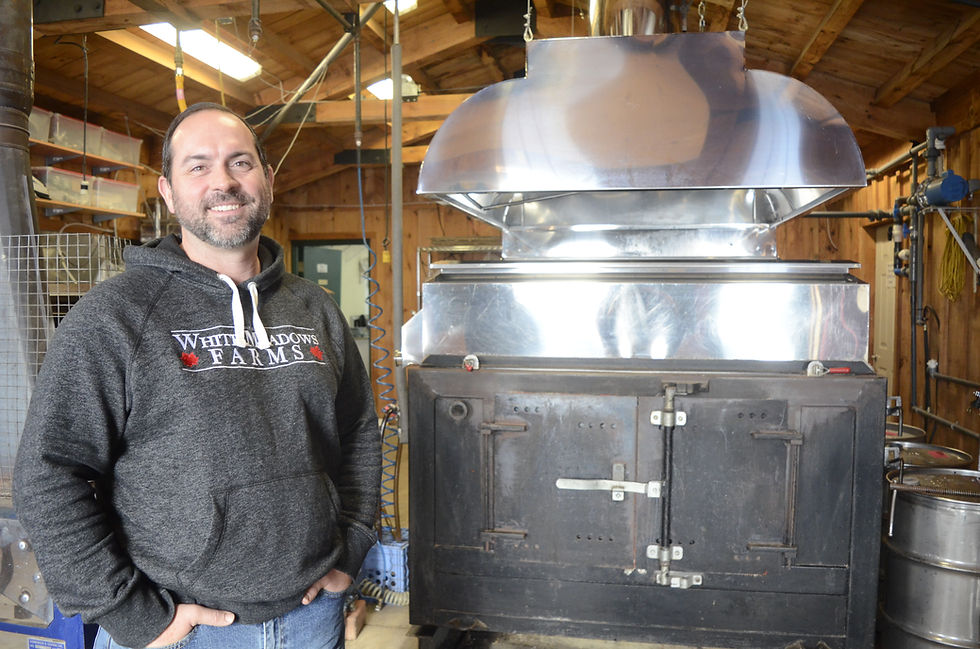The sweetest of seasons is on tap at White Meadows Farms
- Luke Edwards
- Feb 6
- 4 min read

By Luke Edwards
Oh how a year can change things.
“Last year we started tapping on Jan. 27, which was the earliest I think we’ve ever done,” said Richard Bering, who runs White Meadows Farms on Effingham Road in rural St. Catharines.
Fast forward to this year and a mid-January cold snap meant it would still be a while yet before the sap was running. That’s not necessarily a bad thing, as Bering is also undergoing a substantial line replacement project involving nearly a kilometre of line.
Starting a little later isn’t a huge issue. The more pressing concern, weather wise, is what happens when the sap does start running. That’s when he’ll be hoping for warm stretches with a couple colder, freezing days mixed in.
“The goal is to have it kind of ready for the end of January,” he said. And then they play the waiting game.
The Bering family is nearing 90 years as stewards of the White Meadows property. They settled on the land in 1937, with first Bering owner Adam raising dairy cattle, cash crops and juice grapes. It got its name from the daisies that would fill the meadow near the house with white every summer.
In 1940, Adam harvested some sap and made maple syrup, in part for fun, and in part for his son Gasper. That started a tradition that was passed on to Gasper, and then Murray, and now Richard.
“It’s really meaningful to be connected in some fashion to the same property. My grandfather, my great grandfather, they walked those paths in the forest,” Bering said.
“The land stewardship is a different mentality when it’s so long term.”
A long term mentality is a good thing in the maple syrup industry, where trees don’t get tapped until they’re 40 years old, and aren’t really in their prime for another 40 after that. Though his young children, at 10 and 12, are primarily confined to the job of taste testers at this point, Bering said he’s always aware the decisions he’s making now will have effects long into the future.
Education is a big part of White Meadows. The spring sugar bush treks are set to begin March 1, and provide an opportunity for visitors to learn about maple syrup, what goes into processing the sweet delicacy, and for Bering and his team to clear up some misconceptions such as why there are different colours of maple syrups and what that means in terms of taste and sugar.
“At the beginning of the season, when it’s colder, the syrup is a very light color. We call it golden, and then as the weather gets warmer, the syrup is darker,” Bering said.
“So what happens is the type of sugar in a sap is changing as the weather changes. and the different types of sugar react differently in the boiling process.”
Thanks in part to his wife Amanda, who helps run the farm and conveniently has a master’s degree in molecular biology, Bering is able to explain why the colours differ. Essentially it all boils down - so to speak - to the maillard reaction and the breakdown of different complex sugars.
It has nothing to do with how long or how hot they boil the sap, a common misunderstanding.
Bering resists sharing what his favourite colour is, lest he sway the public opinion. However, he does point out that each colour has a certain area where they shine. The darker, amber syrups are often well suited to cooking, while on the other end of the spectrum, the lighter ones are used as toppings or to make maple specific products like maple butter.
The boiling process that creates maple syrup has a long history, and remains essentially unchanged from the days when Indigenous people first created maple syrup.
However, that doesn’t mean everything has been static.
“There’s been a tremendous amount of improvement in the tools and supplies that are available to us now,” he said.
Better lines that can withstand the summer sun and winter cold mean they can leave them out year round and still last 15 years. New spiles have check valves that prevent sap that has gone into the line from being sucked back into the tree during a cool night. This prevents bacteria that could be in the line from infecting the tree.
Climate change has also affected them, Bering said, with seasons fluctuating more. Last year’s record breaking Jan. 27 start wasn’t terribly surprising, as the season is extending on both ends, with the start being as early as Jan. 27 or as late as mid-March.
That means sometimes Bering is in a rush to get things set up, only to have to wait for the weather to turn.
“It’s kind of just all messed up in both directions,” he said.
Since it’s such a long-term process, there’s not a lot people like Bering can do. Ensuring the holes in the trees are clean is one way to help.
“So if we could keep the hole as clean as possible, it’ll stay productive as long as possible,” he said.
In recent years White Meadows has opened two off-farm shops in Niagara Falls and Niagara-on-the-Lake. Bering said they maintain a similar focus of education at the shops, and have been received well. With so many international visitors coming to Niagara each year, he said seeing people learn about maple syrup and often try it for the first time at one of their locations is one of his favourite parts of the job.
Those interested in visiting the farm for the spring sugar bush trek can book tickets online at whitemeadowsfarms.com. More information on the business, their offerings, and the two off-farm shops can also be found there.




Comments